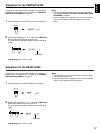
30
In areas where RDS broadcasts cannot be received, the RDS broadcast functions do not operate. (The procedures from page 30 to
page 34 are not necessary.)
RECEIVING RDS STATIONS (HTR-5130RDS only)
RDS (Radio Data System) is a data transmission system gradually being introduced by FM stations in many countries. Stations
using this system transmit an inaudible stream of data in addition to the normal radio signal.
RDS data contains various information, such as PI (Program Identification), PS (Program Service name), PTY (Program Type), RT
(Radio Text), CT (Clock Time), EON (Enhanced Other Networks), etc.
RDS function is carried out among the network stations.
* This unit utilizes PI, PS, PTY, RT, CT and EON to receive RDS broadcast stations.
Displaying RDS data
PRESET
kHz
MHz
MEMORY
AUTO PTY HOLD
SLEEP
TAPE MON
STEREO
0
20
l00
ms dB
PRO LOGIC
ENHANCED
CONCERT
VIDEO
MONO
MOVIE
STADIUM
DISCO
ROCK CONCERT
CONCERT HALL
NORM
WIDE
PHANTOM
EFFECT OFF
PS
EON
AFFAIRS SPORT
NEWS INFO
RT CTPTY
This unit can be turned into the following five modes to display
RDS data.
PS (Program Service name) mode:
Displays the name of the RDS station currently being received
instead of the frequency.
PTY (Program Type) mode:
Displays the type of the program on the RDS station currently
being received. There are 15 program types to classify RDS
stations. Refer to the next page for details.
RT (Radio Text) mode:
Displays information about the program (such as title of the
song, name of the singer, etc.) on the RDS station currently
being received.
CT (Clock Time) mode:
Displays current time. This signal comes from the RDS station
currently being received.
EON (Enhanced Other Networks)
mode:
Automatically receives a program of the designated program
type when its broadcast starts in place of the program currently
being received. When the broadcast of the called program
ends, the previously received program (or another program on
the same station) is recalled.


















